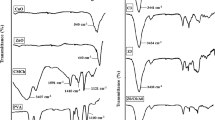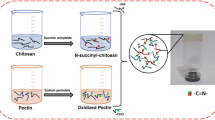Abstract
The present paper reports on the preparation of hybrid polymeric hydrogels consisting of poly(vinylalcohol) (PVA) and Chitosan (CHI) blends and relevant composites loaded with multiwalled carbon nanotubes (MWCNT). The hydrogels, prepared by the physical freeze-drying method were specifically characterized in the merit of their morphological, thermal and swelling/deswelling behavior. The obtained results indicate that PVA/CHI/MWCNTs hydrogel nanocomposites appear good candidates for biomedical and pharmaceutical applications. The presence of up to 0,5 % MWCNTs in the investigated polymeric hydrogel composites does not negatively affect the biocompatibility of the PVA/CHI hybrid polymeric blends used as continuous matrix.
Access this chapter
Tax calculation will be finalised at checkout
Purchases are for personal use only
Preview
Unable to display preview. Download preview PDF.
Similar content being viewed by others
References
Tanaka K, Yamabe T, Fukui K (1999) The science and technology of carbon nanotubes. Elsevier, Amsterdam
Salvetat JP, Kulik A, Bonard JM et al (1999) Elastic modulus of ordered and disordered multiwalled carbon nanotubes. Adv Mater 2:161–165
Supronowicz PR, Ullman KR, Ajayan PM et al (2001) Cellular/molecular responses of electrically stimulated osteoblasts cultured on novel polymer/carbon nanophase substrates. In: Carbon OI, An International Conference on Carbon, Lexington, KY, United States, July 14–19. University of Kentucky, Center for Applied Energy Research Library, Lexington, pp 1–2
Cadek M, Coleman JN, Ryan KP et al (2004) Reinforcement of Polymers with Carbon Nanotubes: The Role of Nanotube Surface Area. Nano Lett 4:353–356
Calvert P (1999) Nanotube composites: A recipe for strength. Nature 399:210–211
Richard C, Balavoine F, Schultz P et al (2003) Supramolecular self-assembly of lipid derivatives on carbon nanotubes. Science 300:775–778
Gao HJ, Kong Y, Cui DX et al (2003) Spontaneous insertion of DNA oligonucleotides into carbon nanotubes. Nano Lett 3:471–473
Chen J, Hamon MA, Hu H et al (1998) Solution properties of single-walled carbon nanotubes. Sciente 282:95–98
O’Connell MJ, Boul P, Ericson LM et al (2001) Reversible water-solubilization of single-walled carbon nanotubes by polymer wrapping. Chem Phys Lett 342:265–271
Li H, Wang DQ, Chen HL et al (2003) A novel gelatin-carbon nanotubes hybrid hydrogel. Macromol Biosci 3:720–724
Tong X, Zheng J, Lu Y et al (2007) Swelling and mechanical behaviors of carbon nanotube/poly (vinyl alcohol) hybrid hydrogels. Mater Lett 61:1704–1706
Balavoine F, Schultz P, Richard C et al (1999) Helical crystallization of proteins on carbon nanotubes: A first step towards the development of new biosensors. Angew Chem. Int Edit 38:1912–1915
Mattson MP, Haddon RC, Rao AM (2000) Molecular functionalization of carbon nanotubes and use as substrates for neuronal growth. J Mol Neurosci 14:175–182
Yildirim ED, Yin X, Ko FK et al (2006) Evaluation of 3D Hybrid Alginate/Single Wall Carbon Nanotube Tissue Scaffolds in Terms of Process and Cytocompatibility. Bioengineering Conference, Proceedings of the IEEE 32nd Annual Northeast, 01-02 April, pp 5–6
Abarrategi A, Gutierrez MC, Moreno-Vicente C et al (2008) Multiwall carbon nanotube scaffolds for tissue engineering purposes. Biomaterials 29:94–102
Cadek M, Coleman JN, Barron V et al (2002) Morphological and mechanical properties of carbon-nanotube-reinforcedsemicrystalline and amorphous polymer composites. Appl Phys Lett 81:5123–5125
Gong HP, Zhong YH, Li JC et al (2000) Studies on nerve cell affinity of chitosan-derived materials. J Biomed Mater Res 52:285–295
Drury JL, Mooney DJ (2003) Hydrogels for tissue engineering: scaffold design variables and applications. Biomaterials 24:4337–4351
Zhao L, Mitomo H, Zhai ML et al (2003) Synthesis of antibacterial PVA/CM-chitosan blend hydrogels with electron beam irradiation. Carbohyd Polym 53:439–446
Fernandes EG, Krauser S, Samour CM, Chiellini E (2000) Symmetric block oligomers. Gelation characteristics by DSC. J Therm Anal Cal 61:551–564
Author information
Authors and Affiliations
Rights and permissions
Copyright information
© 2009 Springer-Verlag Italia, Milan
About this chapter
Cite this chapter
Samal, S.K., Chiellini, F., Bartoli, C., Fernandes, E.G., Chiellini, E. (2009). Hybrid Hydrogels Based on Poly(vinylalcohol)-Chitosan Blends and Relevant CNT Composites. In: Hydrogels. Springer, Milano. https://doi.org/10.1007/978-88-470-1104-5_7
Download citation
DOI: https://doi.org/10.1007/978-88-470-1104-5_7
Publisher Name: Springer, Milano
Print ISBN: 978-88-470-1103-8
Online ISBN: 978-88-470-1104-5
eBook Packages: Chemistry and Materials ScienceChemistry and Material Science (R0)




